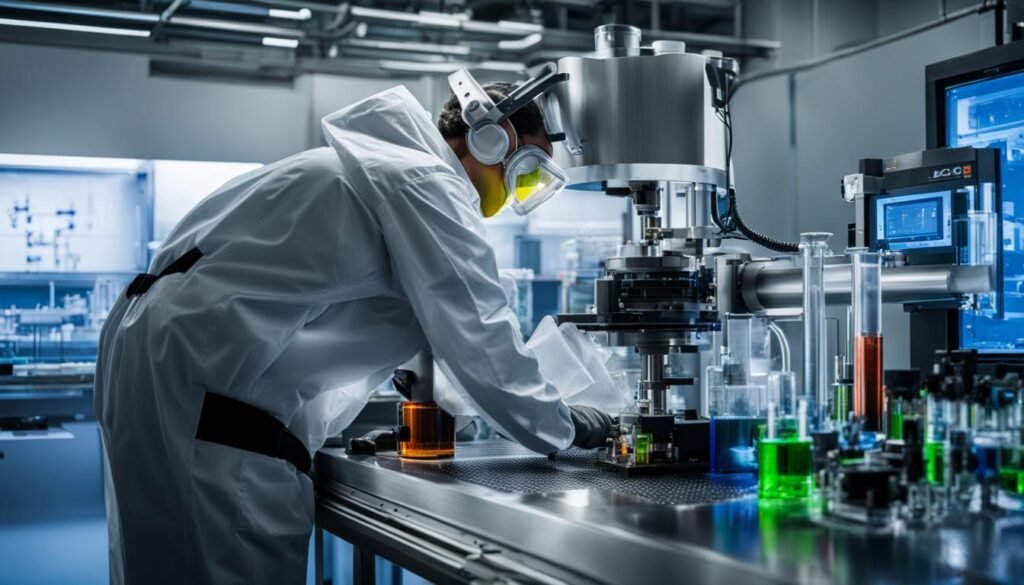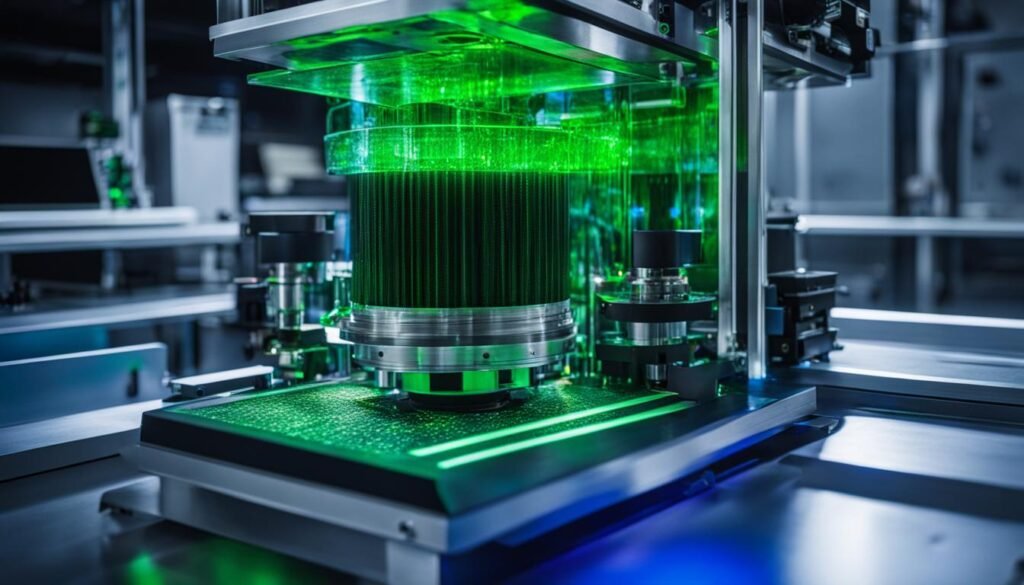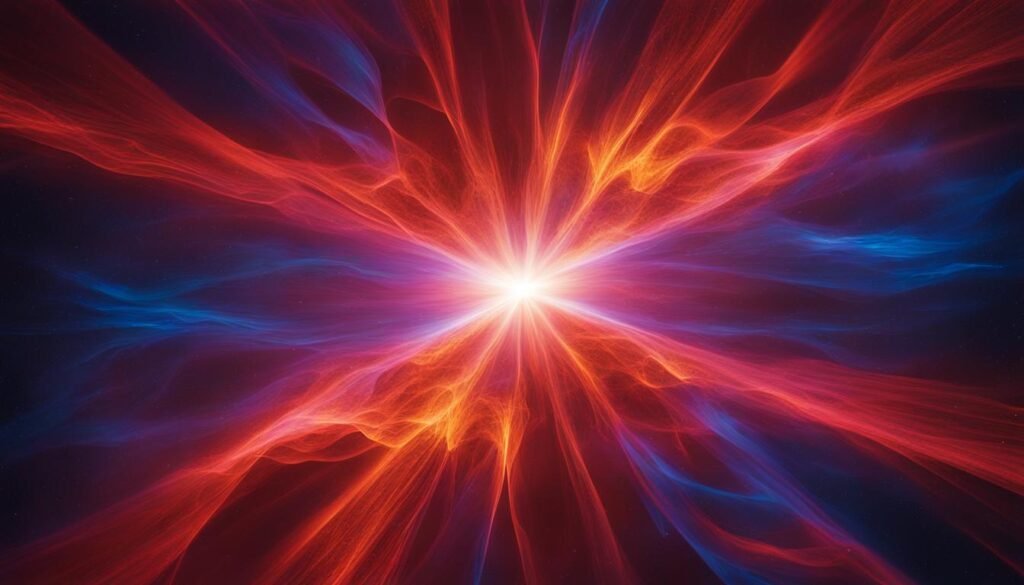Contents
- 1 Understanding Laser-assisted Chemical Vapor Deposition (LCVD)
- 2 Applications of Laser-assisted Chemical Vapor Deposition (LCVD)
- 3 Advantages of Laser-assisted Chemical Vapor Deposition (LCVD)
- 4 Challenges in Laser-assisted Chemical Vapor Deposition (LCVD)
- 5 Current State of Laser-assisted Chemical Vapor Deposition (LCVD) in the US
- 6 Future Outlook for Laser-assisted Chemical Vapor Deposition (LCVD)
- 7 Conclusion
- 8 FAQ
- 9 Source Links
Laser-assisted Chemical Vapor Deposition (LCVD) is a cutting-edge process used in material science for depositing thin films. In this comprehensive guide, we will explore the ins and outs of LCVD technology, its applications, and the current state of LCVD in the United States. Join us on this journey as we delve into the advantages and challenges of LCVD, and discover how it is shaping the world of modern material science.
Key Takeaways:
- LCVD is a process used in material science for depositing thin films.
- It involves the use of laser technology to promote chemical reactions and deposit material onto a substrate.
- LCVD has diverse applications in electronics, optics, and biomedicine.
- Precise control over film thickness and composition is one of the key advantages of LCVD.
- While LCVD presents challenges such as precursor gas selection and process optimization, ongoing research and development are driving advancements in the field.
Understanding Laser-assisted Chemical Vapor Deposition (LCVD)
Laser-assisted Chemical Vapor Deposition (LCVD) is a precise and versatile process that involves the deposition of thin films of material onto a substrate using laser technology. The LCVD process begins with the introduction of a precursor gas into a reaction chamber. A laser beam is then applied to the gas, triggering chemical reactions that lead to the deposition of material onto the surface of the substrate. This deposition process allows for the creation of thin films with controlled properties such as thickness, composition, and microstructure.
LCVD is widely used in various industries, particularly in the fabrication of electronic devices and optical coatings. For example, in the electronics industry, LCVD is used for depositing conductive materials like metal films, which are essential for interconnects and device electrodes. Additionally, LCVD is crucial in the production of optical coatings such as anti-reflective coatings and thin-film filters. The precise control provided by LCVD makes it a valuable technique for creating advanced materials with tailored properties.
Advantages of LCVD
LCVD offers several advantages over other deposition techniques. One of the key advantages is the precise control it provides over film thickness, composition, and microstructure. This enables the production of high-quality films with uniform properties. Another advantage of LCVD is its ability to deposit materials with complex geometries and high aspect ratios. This makes it suitable for creating microscale and nanoscale structures. Additionally, LCVD can be performed at relatively low temperatures, minimizing thermal stress on the substrate and allowing for the deposition of films on temperature-sensitive materials.
Challenges in LCVD
Despite its advantages, LCVD also presents certain challenges. One of the main challenges is the selection of appropriate precursor gases, as they play a crucial role in determining the chemical reactions and properties of the deposited material. Process optimization is another challenge, as the laser energy and deposition parameters must be carefully controlled to ensure consistent and reliable film growth. Furthermore, integrating LCVD into existing manufacturing processes and equipment can be complex and requires further research and development.
| Advantages of LCVD | Challenges in LCVD |
|---|---|
| Precise control over film properties | Selection of appropriate precursor gases |
| Deposition of materials with complex geometries | Process optimization |
| Low-temperature deposition | Integration into existing manufacturing processes |
Overall, LCVD is a powerful technology with a wide range of applications and exciting potential for the future of material science and advanced manufacturing.
Applications of Laser-assisted Chemical Vapor Deposition (LCVD)
Laser-assisted Chemical Vapor Deposition (LCVD) has a wide range of applications in various industries, making it a versatile technique for creating advanced materials with tailored properties. In the electronics industry, LCVD is commonly used for depositing conductive materials, such as metal films, for interconnects and device electrodes. This enables the production of high-performance electronic devices with superior conductivity and reliability.
LCVD also plays a crucial role in the production of optical coatings. By depositing thin films using precise control over thickness and composition, LCVD is used for creating anti-reflective coatings, thin-film filters, and other optical coatings. These coatings enhance the performance of optical devices by reducing reflections, improving light transmission efficiency, and providing tailored optical properties.
In addition to electronics and optics, LCVD finds applications in the fabrication of sensors, catalysts, and biomedical devices. Its ability to deposit materials with high aspect ratios and complex geometries makes it ideal for creating microscale and nanoscale structures that are crucial for these applications. LCVD enables the development of advanced sensors with high sensitivity and selectivity, catalysts with optimized surface properties, and biomedical devices with tailored functionalities.
Table: Applications of Laser-assisted Chemical Vapor Deposition (LCVD)
| Industry | Application |
|---|---|
| Electronics | Conductive interconnects and device electrodes |
| Optics | Anti-reflective coatings, thin-film filters |
| Sensors | High-performance sensors with tailored properties |
| Catalysis | Optimized catalysts with controlled surface properties |
| Biomedical | Advanced biomedical devices with tailored functionalities |
These examples highlight the broad applications of LCVD across different industries. Its precise control over film deposition allows for the creation of materials with specific properties required for each application. As the technology continues to advance, it is likely that new applications for LCVD will continue to emerge, further expanding its impact in various fields.
Advantages of Laser-assisted Chemical Vapor Deposition (LCVD)
Laser-assisted Chemical Vapor Deposition (LCVD) offers numerous advantages that make it a preferred technique for depositing thin films with exceptional precision and quality. One of the key advantages of LCVD is its ability to provide precise control over film thickness, composition, and microstructure. This level of control allows researchers and manufacturers to tailor the properties of the deposited material to meet specific requirements.
LCVD also enables the deposition of high-quality films with uniform properties. The laser-based approach ensures that the deposited material is uniform throughout the entire film, resulting in consistent and reliable performance. This is particularly important in applications where material uniformity is critical, such as electronic devices and optical coatings. The precise control offered by LCVD also allows for the deposition of materials with high aspect ratios and complex geometries, making it suitable for creating microscale and nanoscale structures.
Another advantage of LCVD is its ability to operate at relatively low temperatures. Unlike some other deposition techniques that require high temperatures, LCVD can be performed at lower temperatures, minimizing thermal stress on the substrate and allowing for the deposition of films on temperature-sensitive materials. This temperature flexibility expands the range of materials that can be deposited using LCVD, making it a versatile technique in material science.
Table: Advantages of Laser-assisted Chemical Vapor Deposition (LCVD)
| Advantages | Description |
|---|---|
| Precise control | Allows for precise control over film thickness, composition, and microstructure |
| High-quality films | Enables the deposition of high-quality films with uniform properties |
| Flexibility in material deposition | Can be performed at relatively low temperatures, minimizing thermal stress on the substrate and facilitating the deposition on temperature-sensitive materials |
In summary, the advantages of Laser-assisted Chemical Vapor Deposition (LCVD) lie in its precise control over film properties, the ability to deposit high-quality and uniform films, and the flexibility to operate at lower temperatures. These advantages make LCVD a powerful technique for a range of applications in material science, electronics, optics, and beyond.
Challenges in Laser-assisted Chemical Vapor Deposition (LCVD)
Laser-assisted Chemical Vapor Deposition (LCVD) offers numerous advantages in thin film deposition, but it also presents certain challenges that need to be addressed for the optimal utilization of this technology. One key challenge is the selection of appropriate precursor gases, as they play a crucial role in determining the chemical reactions and properties of the deposited material. Different precursor gases can result in variations in film composition, structure, and properties, making gas selection a critical aspect of the LCVD process.
Process optimization is another challenge in LCVD. The laser energy and deposition parameters need to be carefully controlled to ensure consistent and reliable film growth. The optimization of laser power, scan speed, and gas flow rate is essential to achieve the desired film properties, such as thickness, uniformity, and adhesion. Fine-tuning these parameters requires a deep understanding of the interaction between the laser beam, precursor gases, and the substrate.
“The selection of appropriate precursor gases and process optimization are key challenges in maximizing the potential of LCVD.”
The integration of LCVD into existing manufacturing processes and equipment can also be complex. Adapting LCVD to fit within the constraints and requirements of different industries and applications requires careful consideration of factors such as scalability, compatibility, and cost-effectiveness. The successful implementation of LCVD in industrial settings involves overcoming engineering challenges and ensuring seamless integration with other manufacturing steps.
To overcome these challenges, ongoing research and development efforts are being undertaken in the field of LCVD. These efforts aim to develop new precursor gases with enhanced properties, optimize process parameters for specific applications, and improve the scalability and reliability of the technology. Through multidisciplinary collaborations and innovative approaches, researchers are striving to unlock the full potential of LCVD and address the challenges that currently limit its widespread adoption.
| Challenges in LCVD | Solutions |
|---|---|
| Precursor gas selection | Continued research and development to identify and develop new precursor gases with desired properties. |
| Process optimization | Ongoing experimentation and optimization of laser power, scan speed, and gas flow rate to achieve desired film properties. |
| Integration with existing processes | Engineering solutions to seamlessly integrate LCVD into different manufacturing environments, considering scalability and compatibility factors. |
Current State of Laser-assisted Chemical Vapor Deposition (LCVD) in the US

In the United States, the field of laser-assisted chemical vapor deposition (LCVD) is experiencing significant growth and development. Academic institutions, government research labs, and industrial companies are actively engaged in research and development efforts to explore the potential applications and advancements in LCVD technology. The focus is on refining the understanding of the deposition process, optimizing precursor gas selection, and enhancing process monitoring techniques.
One of the key areas of research is the development of novel precursor gases that can yield desired material properties. By tailoring the chemical reactions and composition of the deposited films, researchers aim to expand the range of materials that can be produced using LCVD. This research is crucial for addressing the diverse needs of industries such as electronics, optics, and biomedicine.
The ongoing research and development efforts in the US have also resulted in advancements in laser systems used in LCVD. Improved laser sources offer higher power, better beam quality, and greater control, enabling more precise and efficient deposition processes. This allows for the fabrication of complex and multifunctional material structures with enhanced properties.
| Research Areas | Industry Adoption |
|---|---|
| Development of novel precursor gases | Increasing interest from electronics, optics, and biomedical industries |
| Advancements in laser systems | Growing adoption in research and development labs |
| Process optimization and monitoring techniques | Exploring potential for industrial-scale production |
“The ongoing research and development efforts in LCVD technology are paving the way for new applications and advancements in material science. With the collaborative efforts of academia, research labs, and industry, we can expect to see significant growth and adoption of LCVD in the coming years.”
The current state of LCVD in the US is marked by a strong emphasis on research and innovation. While there has been substantial progress in understanding the fundamental principles of LCVD and its potential applications, the widespread adoption of LCVD in commercial industries is still in its early stages. However, as the technology continues to mature and advancements are made, it is expected that LCVD will play a vital role in shaping the future of material science and advanced manufacturing in the United States.
Future Outlook for Laser-assisted Chemical Vapor Deposition (LCVD)

The future of LCVD holds immense potential and exciting possibilities. As researchers continue to advance our understanding of the deposition process, we can expect to see emerging applications and groundbreaking developments in this field. Technological advancements will play a crucial role in shaping the future of LCVD, opening up new avenues for innovation and pushing the boundaries of what is possible.
One of the key areas of focus for future LCVD research is in the development of novel precursor gases. By exploring and harnessing new chemical reactions, scientists aim to expand the range of materials that can be deposited using LCVD. This will pave the way for the creation of unique and tailored materials with enhanced properties, further expanding the scope of LCVD applications.
Additionally, advancements in laser systems will drive the evolution of LCVD. Researchers are constantly working to improve the performance and efficiency of lasers used in the deposition process. This includes increasing laser power, enhancing beam quality, and optimizing beam delivery systems. These technological advancements will enable more precise and controlled deposition, facilitating the creation of high-quality and complex structures.
“The future of LCVD holds immense potential and exciting possibilities.”
The integration of LCVD with other additive manufacturing techniques, such as 3D printing, also presents an exciting future prospect. By combining the precision of LCVD with the versatility of 3D printing, it becomes possible to fabricate intricate and multifunctional material structures. This opens up endless possibilities for applications in fields such as electronics, healthcare, and aerospace, where complex and customized designs are in demand.
In conclusion, the future of LCVD is bright and promising. With emerging applications, technological advancements, and ongoing research and development efforts, this technology will continue to shape the landscape of material science and advanced manufacturing. As we unlock new possibilities and push the boundaries of what can be achieved, the impact of LCVD will be felt across industries, driving innovation and propelling us into a new era of materials engineering.
Conclusion
Laser-assisted Chemical Vapor Deposition (LCVD) is a groundbreaking technology with immense potential in the field of material science. By allowing precise control over film properties, LCVD enables the deposition of high-quality thin films with tailored characteristics. This versatile technique finds applications in diverse industries, including electronics, optics, and biomedicine.
While challenges such as precursor gas selection and process optimization exist, ongoing research and development efforts are addressing these obstacles. With advancements in understanding and control, LCVD is projected to unlock new opportunities for material science in the future. Additionally, the integration of LCVD with emerging technologies like 3D printing amplifies the possibilities for creating complex and multifunctional material structures.
In summary, LCVD’s future prospects are bright. As the technology matures and further advancements are made, its impact will extend beyond the United States. LCVD has the potential to revolutionize advanced manufacturing and shape the future of material science on a global scale. Stay tuned for new breakthroughs and exciting applications in the world of laser-assisted Chemical Vapor Deposition.
FAQ
What is Laser-assisted Chemical Vapor Deposition (LCVD)?
LCVD is a process used in material science for depositing thin films onto a substrate using laser technology.
How does the LCVD process work?
A precursor gas is introduced into a reaction chamber, where it is subjected to a laser beam. The laser energy promotes chemical reactions that result in the deposition of material onto the substrate surface.
What are the applications of LCVD?
LCVD is commonly used in the fabrication of electronic devices, optical coatings, and other advanced materials. It can also be applied in the production of sensors, catalysts, and biomedical devices.
What are the advantages of LCVD?
LCVD offers precise control over film thickness and composition, allowing for the creation of high-quality films with uniform properties. It also enables the deposition of materials with complex geometries and can be performed at relatively low temperatures.
What are the challenges in LCVD?
The selection of appropriate precursor gases and process optimization are key challenges in LCVD. Additionally, the integration of LCVD into existing manufacturing processes and equipment can be complex.
What is the current state of LCVD in the US?
LCVD is a rapidly evolving technology in the US, with ongoing research and development efforts in academic institutions, government research labs, and industrial companies. However, its widespread adoption in commercial applications is still in the early stages.
What is the future outlook for LCVD?
As research and development continue to advance the understanding and control of the deposition process, new applications for LCVD are expected to emerge. The development of novel precursor gases, improved laser systems, and enhanced process monitoring techniques will further enhance the capabilities of LCVD.



